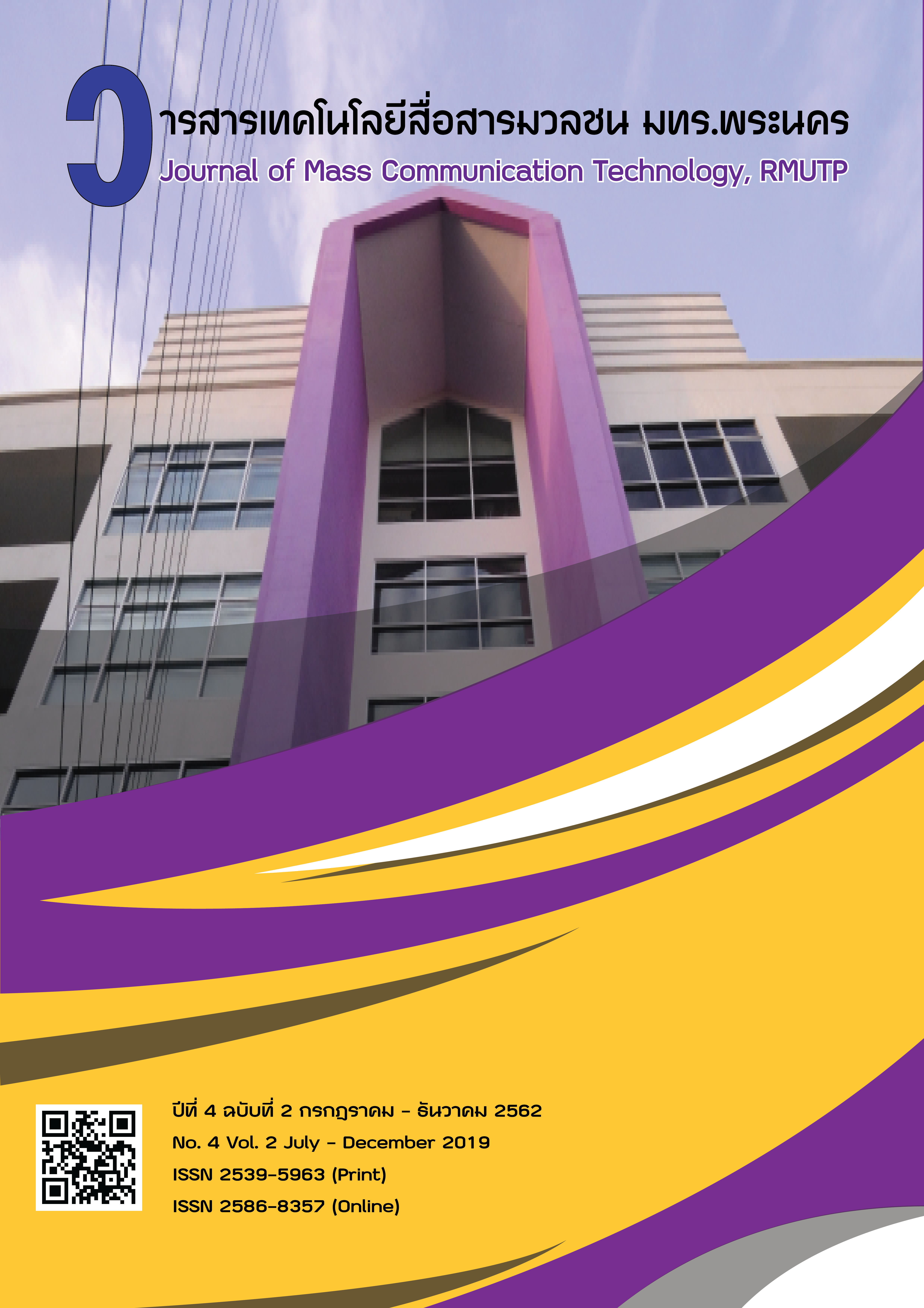ผลกระทบของความคล้ายคลึงกับตัวละครในผู้ชมภาพยนตร์ที่มีต่อความตั้งใจ เชิงพฤติกรรมในด้านดีผ่านการจินตนาการร่วมกับตัวละคร
คำสำคัญ:
คล้ายคลึง, ความตั้งใจเชิงพฤติกรรม, การจินตนาการร่วมกับตัวละคร, ภาพยนตร์บทคัดย่อ
งานวิจัยนี้มีวัตถุประสงค์เพื่อทดสอบผลกระทบของความคล้ายคลึงกับตัวละครของผู้ชมภาพยนตร์ที่มีต่อความตั้งใจเชิงพฤติกรรม ทั้งโดยตรง และโดยผ่านตัวแปรส่งผ่าน คือ การจินตนาการร่วมไปกับตัวละคร ความตั้งใจเชิงพฤติกรรมในงานวิจัยนี้หมายถึง ความตั้งใจที่จะมีพฤติกรรมดีต่อเพื่อนร่วมห้องในหอพัก กลุ่มตัวอย่าง จำนวน 106 คน ได้ถูกขอให้ชมภาพยนตร์เกี่ยวกับพฤติกรรมที่ไม่ดีในการใช้ชีวิตในหอพัก ซึ่งส่งผลไม่ดีตามมา หลังจากชมภาพยนตร์พวกเขาได้ทำแบบสอบถามซึ่งมี 3 ส่วนเพื่อวัดค่าของตัวแปร 3 ตัวที่ต้องการทดสอบ การวิเคราะห์เส้นทางได้ถูกใช้เพื่อศึกษาผลกระทบโดยตรงและทางอ้อมจากความคล้ายคลึงกับตัวละครที่มีต่อความตั้งใจเชิงพฤติกรรม ผลการวิจัยแสดงให้เห็นว่าไม่มีอิทธิพลโดยตรงของความคล้ายคลึงกับตัวละครที่มีต่อความตั้งใจเชิงพฤติกรรม แต่มีอิทธิพลทางอ้อมโดยผ่านการจินตนาการร่วมไปกับตัวละครอย่างมีนัยสำคัญทางสถิติ ผลการวิจัยนี้ชี้ให้เห็นว่า ภาพยนตร์สั้นมีประโยชน์ในการสอนสิ่งที่ดีต่อผู้ชม โดยเฉพาะอย่างยิ่งในยุคดิจิทัลซึ่งผู้ชมมีความสนใจสั้นลง เนื่องจากโมเดลของงานวิจัยนี้ ได้ถูกทดสอบผลกระทบจากสื่อในระยะสั้น ดังนั้น งานวิจัยในอนาคตควรทดสอบว่า ความสัมพันธ์ที่ค้นพบดังกล่าวจะมีผลในระยะยาวเช่นกันหรือไม่
เอกสารอ้างอิง
กัญจน์ดามาศ โกพล และ สุพัชรจิต จิตประไพ. (2556). บทบาทของละครย้อนยุคที่มีต่อการสืบสานและอนุรักษ์มรดกวัฒนธรรมไทย. วารสารกระแสวัฒนธรรม, 14(26), 57-69.
ชลธิชา แช่มชื่น และ ดุษฎี นิลดำ. (2562). ปัจจัยทางการตลาดที่ส่งผลต่อการบริโภคแก้วเจ้าจอมเบเกอรี่. วารสารเทคโนโลยีสื่อสารมวลชน มทร.พระนคร, 4(1), 60-67.
ดุษฎี นิลดำ, ศุภกร ไกรษร, จักรกฤษณ์ กลิ่นเพ็ชร, และ ณัฐนันท์ เจริญวงษา. (2562). อุดมการณ์ในภาพยนตร์เรื่อง “ฉลาดเกมส์โกง”. วารสารเทคโนโลยีสื่อสารมวลชน มทร.พระนคร, 4(1), 68-75.
พรจันทร์ เสียงสอน (2557). การนำเสนอผู้หญิงและความรุนแรงในภาพยนตร์ไทย. วารสารนิด้าภาษาและ
การสื่อสาร, 19(23), 12-37.
พรนิมิต ธิราช และ ภัสวลี นิติเกษตรสุนทร. (2017). การเล่าเรื่องและการสื่อความหมายของภาพยนตร์สยองขวัญนอกกระแส. วารสารวิจัยและพัฒนามหาวิทยาลัยราชภัฏเลย, 11(ฉบับพิเศษ), 25-33.
พราว อรุณรังสีเวช และ ธนิต พฤกธรา. (2560). ตัวตนที่ถูกปลุกในการเกิดใหม่ของอีโม: การศึกษาเครื่องแต่งกาย เพลง และความเป็นตัวตนของกลุ่มวัฒนธรรมอีโม ปี 2560. ใน การประชุมวิชาการระดับชาติและนานาชาติครั้งที่ 4 คณะวิทยาการจัดการมหาวิทยาลัยราชภัฏสวนสุนันทา. กรุงเทพ: มหาวิทยาลัยราชภัฏสวนสุนันทา.
พราว อรุณรังสีเวช และ สิริพร มีนานันทน์. (2559). สื่อสร้างสรรค์เพื่อการศึกษา. วารสารเทคโนโลยีสื่อสารมวลชน มทร.พระนคร, 1(2), 62-71.
พิยดา ทองประเสริฐ และ วิมลพรรณ อาภาเวท. (2562). การสื่อสารการตลาดกับพฤติกรรมการท่องเที่ยวของนักท่องเที่ยวชาวไทยในพิพิธภัณฑ์ประวัติศาสตร์ในกรุงเทพมหานคร. วารสารเทคโนโลยีสื่อสารมวลชน มทร.พระนคร, 4(1), 18-27.
ภัทราวดี ธีเลอร์. (2560). กรณีศึกษาเรื่องบาปบุญที่สะท้อนผ่านละครไทย. วารสารนักบริหาร, 33(3), 59-65.
วิภาวี เวศย์ชวลิต และ บัญชา วงศ์เลิศคุณากร. (2562). ส่วนประสมการตลาดที่มีผลต่อการตัดสินใจเลือกชมภาพยนตร์ในโรงภาพยนตร์ในกรุงเทพมหานคร. วารสารเทคโนโลยีสื่อสารมวลชน มทร.พระนคร, 4(1), 28-37.
สรรพัชญ์ เจียระนานนท์. (2558). การนำเสนอเนื้อหาของซีรี่ส์ ฮอร์โมน วัยว้าวุ่น ซีซั่น 2. วารสารสารสนเทศ, 14(1), 1-8.
สุพิชฌา วัฒนะ และ ประกายกาวิล ศรีจินดา. (2562). กลยุทธ์การตลาดของร้านแก้วเจ้าจอมเบเกอรี่. วารสารเทคโนโลยีสื่อสารมวลชน มทร.พระนคร, 4(1), 50-59.
อุรพงศ์ แพทย์คชา. (2559). องค์ประกอบภาพยนตร์และปัจจัยสื่อสารการตลาดแบบผสมผสานที่ส่งผลต่อพฤติกรรมการชมภาพยนตร์ไทยประเภทรักโรแมนติก. วารสารวิจัยราชภัฏพระนคร สาขามนุษยศาสตร์และสังคมศาสตร์, 11(1), 74-89.
Abi-Khalil, T, & Mady, C. (2016). Gossip Girl setting fashion trends: Lebanese young viewers’ identification with media characters. Journal of Media and Communication Studies, 8(8), 83-89.
Arunrangsiwed, P. (2014). The Documentary Analysis of Meta-Analysis Research in Violence of Media. World Academy of Science, Engineering and Technology, International Journal of Social, Behavioral, Educational, Economic, Business and Industrial Engineering, 8(1),
77-80.
Arunrangsiwed, P. (2015). Be Like Me & Follow Me: A Relationship between Homophily and Belief of Superheroes’ Fans. Rangsit University Journal of Communication Art, 18(2),
35-50.
Arunrangsiwed, P., Bunyapukkna, P., Ounpipat, N., & Inpayung, P. (2018). Wannabe Effect:
The Study of Wishful Identification and Prosocial Media Effect. In The 3rd Technology Innovation Management and Engineering Science International Conference (TIMES-iCON2018). Bangkok: Mahidol University.
Arunrangsiwed, P., Jareonpon, P., Suwan, T., Wichakam, A., Atta-Arunwong, P., Cheachainart, K., & Bunyapukkna, P. (2018). The Influence of Fan’s Superhero Preference, Superhero’s Leadership, and Ethics on Fans’ Leadership Imitation. In New York International Business and Social Science Research Conference 2018 (pp. 31). Long Island City,
New York, USA: Australian Academy of Business Leadership.
Arunrangsiwed, P., & Klahan, M. (2019). The Influence of Endorsers’ Attractiveness and Similarity Identification on Perceived Product Value. Suan Sunandha Rajabhat University Journal of Management Science (JMS SSRU), 6(1), 13-28.
Arunrangsiwed, P., Komolsevin, R., & Beck, C. S. (2017). Fan Activity as Tool to Improve Learning Motivation. Suan Sunandha Rajabhat University Journal of Management Science (JMS SSRU), 4(2), 16-32.
Birk, M. V., Atkins, C., Bowey, J. T., & Mandryk, R. L. (2016). Fostering Intrinsic Motivation through Avatar Identification in Digital Games. In The 2016 CHI Conference on Human Factors in Computing Systems (pp. 2982-2995). California, US: ACM.
Fink, J. S., Parker, H. M., Brett, M., & Higgins, J. (2009). Off-field behavior of athletes and team identification: Using social identity theory and balance theory to explain fan reactions. Journal of Sport Management, 23(2), 142-155.
Gast, A. (2017). Identification with Game Characters: Effects of visual attributes on the identification process between players and characters (Master's thesis, Södertörns högskola).
George, S. (2018). Watching Game of Thrones in India: Notes on programme culture, television and YouTube. Interactions: Studies in Communication & Culture, 9(3), 275-288.
Ha, J., & Jang, S. S. (2010). Perceived values, satisfaction, and behavioral intentions: The role of familiarity in Korean restaurants. International Journal of Hospitality Management, 29(1), 2-13.
Hefner, D., Klimmt, C., & Vorderer, P. (2007). Identification with the player character as determinant of video game enjoyment. In L. Ma, R. Nakatsu, & M. Rauterberg (Eds.), Entertainment computing–ICEC 2007 (pp. 39-48). Berlin, Heidelberg: Springer, IFIP International Federation for Information Processing.
Hoffner, C., & Buchanan, M. (2005). Young adults' wishful identification with television characters: The role of perceived similarity and character attributes. Media psychology, 7(4), 325-351.
Jennings, N., & Alper, M. (2016). Young Children’s Positive and Negative Parasocial Relationships with Media Characters. Communication Research Reports, 33(2), 96–102.
Keaton, S. A. (2013). Sport team fandom, arousal, and communication: A multimethod comparison of sport team identification with psychological, cognitive, behavioral, affective, and physiological measures (Doctoral dissertation, Louisiana State University).
Lai, W. T., & Chen, C. F. (2011). Behavioral intentions of public transit passengers—The roles of service quality, perceived value, satisfaction and involvement. Transport Policy, 18(2), 318-325.
Mongkolprasit, P., & Arunrangsiwed, P. (2016). The Effect of Prior Characteristic on Perceived Prosocial Content in Media. World Academy of Science, Engineering and Technology, International Journal of Social, Behavioral, Educational, Economic, Business and Industrial Engineering, 10(12), 3526-3530.
Pairoa, I., & Arunrangsiwed, P. (2016). An Overview on the Effectiveness of Brand Mascot and Celebrity Endorsement. World Academy of Science, Engineering and Technology, International Journal of Social, Behavioral, Educational, Economic, Business and Industrial Engineering, 10(12), 3519-3525.
Phillips, N. D., & Strobl, S. (2013). Comic book crime: Truth, justice, and the American way. NY: New York University Press.
Ryu, K., Lee, H. R., & Kim, W. G. (2012). The influence of the quality of the physical environment, food, and service on restaurant image, customer perceived value, customer satisfaction, and behavioral intentions. International Journal of Contemporary Hospitality Management, 24(2), 200-223.
Saleem, M., Anderson, C. A., & Gentile, D. A. (2012). Effects of prosocial, neutral, and violent video games on children's helpful and hurtful behaviors. Aggressive Behavior, 38(4),
281-287.
Turel, O., Serenko, A., & Bontis, N. (2007). User acceptance of wireless short messaging services: Deconstructing perceived value. Information & Management, 44(1), 63-73.
Turel, O., Serenko, A., & Bontis, N. (2010, available online 2009). User acceptance of hedonic digital artifacts: A theory of consumption values perspective. Information & Management, 47(1), 53-59.
ดาวน์โหลด
เผยแพร่แล้ว
รูปแบบการอ้างอิง
ฉบับ
ประเภทบทความ
สัญญาอนุญาต
Copyright (c) วารสารเทคโนโลยีสื่อสารมวลชน มทร.พระนคร
วารสารเทคโนโลยีสื่อสารมวลชน มทร.พระนคร อยู่ภายใต้การอนุญาต Creative Commons Attribution-NonCommercial-NoDerivatives 4.0 International License. (CC BY-Nc-ND 4.0) เว้นแต่จะระบุไว้เป็นอย่างอื่น โปรดอ่านหน้านโยบายของเราสำหรับข้อมูลเพิ่มเติมเกี่ยวกับการเข้าถึงแบบปิด ลิขสิทธิ์ และการอนุญาต




